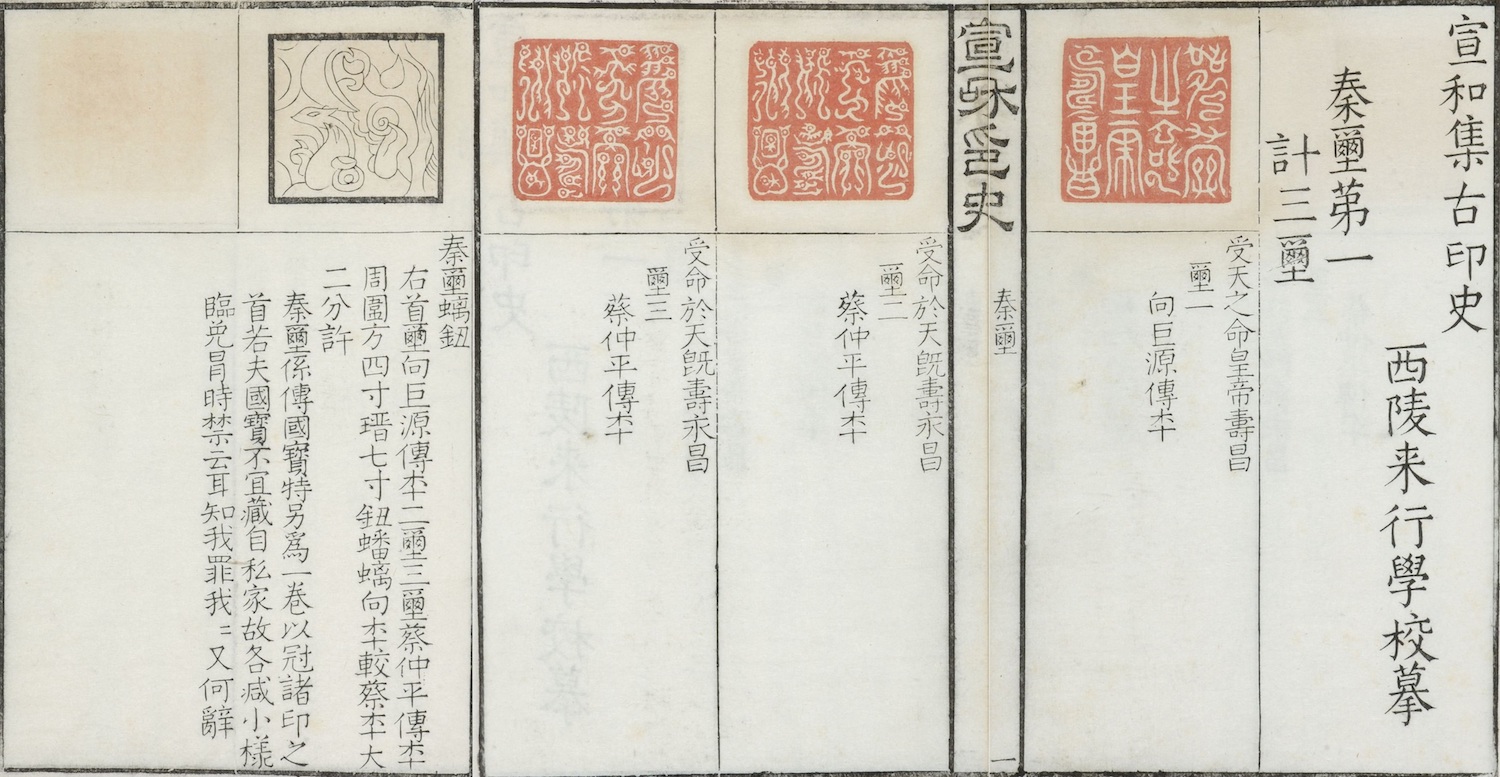Xuanhe ji guyin shi 宣和集古印史 "Ancient seal collection from the Xuanhe reign-period", short Guyinshi 古印史 "A history of ancient seals" or Xuanhe yinshi 宣和印史, is an 8-juan-long text, with an appendix with imperial seals from the Qin period 秦 (221-206 BCE; Qin xi kao 秦璽考). The collection of seals was compiled and commented by Lai Xingxue 來行學 from the Ming period 明 (1368-1644) and was printed in 1596, in eight volumes. It is introduced by two prefaces, one written by the collector Tu Long 屠隆 (1543-1605), and one by Lai Xingxue.
The tradition of collecting and commenting on ancient seals began with Emperor Huizong 宋徽宗 (r. 1100-1125) of the Song dynasty 宋 (960-1279), who, during the Xuanhe reign-period 宣和 (1119-1125), authored the seal catalogue Xuanhe yinpu 宣和印譜. This collection inspired Chao Keyi 晁克一 to publish the Ji guyin ge 集古印格 "Rules for the collection of ancient seals" and Jiang Kui 姜夔 (c. 1155-c. 1221) with his Ji guyin pu 集古印譜 "Notes for the collection of ancient seals". These books are now all lost, but might still have existed in the 18th century, because they are shortly described in the descriptive bibliography Siku quanshu zongmu tiyao 四庫全書總目提要.
Lai Xingxue, courtesy name Yanshu 顏叔, hailed from Xiling 西陵 close to Hangzhou 杭州, Zhejiang, and lived near Mt. Shijing 石箐山. In his preface, he tells the story that he was once ploughing a field, when he detected the fragments of an ancient coffin, among which a wooden case was to be found, lacquered in red. Inside the case, he saw a book with the title Xuanhe yinshi 宣和印史 "History of seals from the Xuanhe reign", wrapped in Sichuanese silk. The short book included reproductions of more than 1,200 ancient official seals and more than 4,300 private seals. The text of the seal inscriptions was transcribed into modern script. Most of the seals, he explained, hailed from the Han period 漢 (206 BCE-220 CE), but the time frame ranged from the Qin to the Sui period 隋 (581-618). Lai's catalogue includes 1,588 seal reproductions. It was published in 1596.
 |
The image to the left is a view of the "seal knob" (yinniu 印鈕) from the top. Source: Guangming zhi men 光明之門, copy owned by the Tōkyō Kokuritsu Hakubutsukan 東京国立博物館. |
Zhang Xicheng 張心澄, author of a critical book on forgeries (Weishu tongkao 偽書通考), thought that Lai's statements about the finding of an old text in a tomb were false. His most important argument is that no book of the title Xuanhe yinshi is mentioned in Song-period bibliographies. Only the appendix of Wuqiu Yan's 吾丘衍 (1268-1311) Xuegubian 學古編 mentions a 4-juan-long book of this title, but it is doubtful whether the content cited is original. The second argument concerns the preserved state of a wooden box and the paper of the book from the Song period that allegedly survived, while the coffin had decayed. The text was therefore not included in the imperial reprint series Siku quanshu 四庫全書.
Eight copies of Lai's book have survived and are to be found in different libraries and museums of mainland China and Taiwan. A modern reproduction was published by the Qi-Lu shushe 齊魯書社 in 1995.